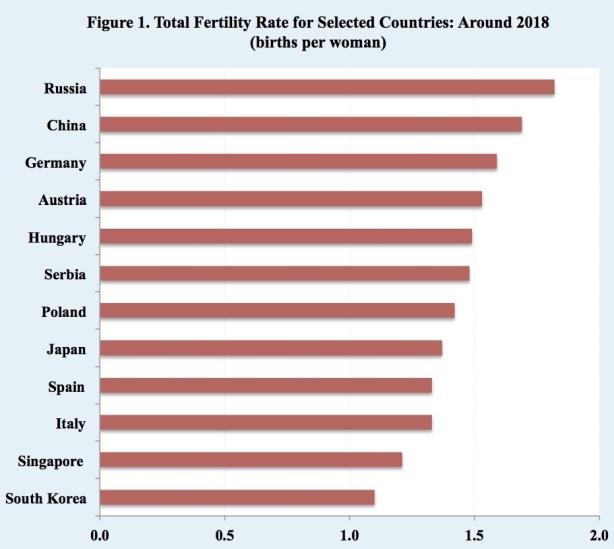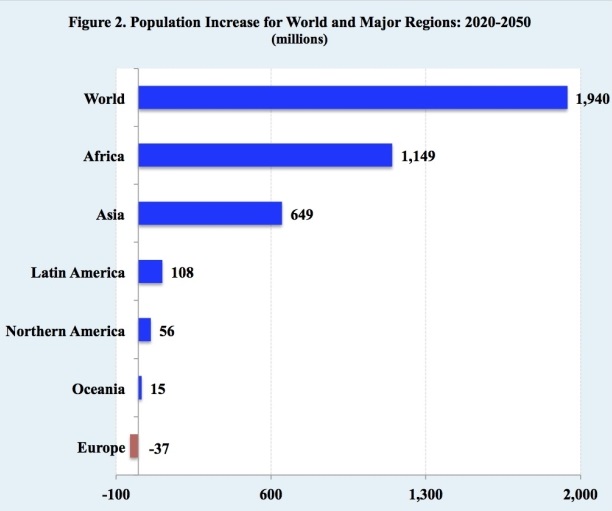Whenever the issue of population comes up, pro-growth demographic dogma invariably dominates. Governments, political parties, businesses, the media and many others typically praise population growth and lament population slowdown, stabilization or decline. The demographic dogma basically advocates maintaining robust population growth and a larger and youthful population.
Population declines, even slowdowns, generally inspire angst among most policymakers, military officials, business leaders, economists and others, as they see them tied to economic, political, social and cultural decline. The dogma foresees financial ruin and a loss of political influence and national power resulting from demographic declines and population aging.
The pro-growth demographic dogma is fundamentally a Ponzi scheme. It is a pyramid scheme that generates more money, power and influence for some by adding on more and more people through natural increase and in some cases immigration. Questions about the sustainability of long-term population growth are typically dismissed or left unanswered.
|
Fear of population decline and aging is promoted by many groups, especially business leaders who tend to gain the most financially from a growing, youthful population of consumers and workers.
For example, while Tesla CEO Elon Musk and Alibaba founder Jack Ma may disagree on many issues, they are in agreement that the biggest problem facing the world in the future is not enough people.
Although world population is projected to add 2 billion people by midcentury, the two prominent businessmen claim, “The biggest issue in 20 years will be population collapse. Not explosion. Collapse.”
In the United States, the Chamber of Commerce regularly calls for the government to continue importing foreign workers. In a recent interview, Chamber CEO Tom Donohue commenting on the ongoing labor shortage in the country said: “The fundamental issue is that the United States of America is out of people.”
However, data from the US Bureau of Labor Statistics show there is no labor shortage. In addition, automation, artificial intelligence and robots are reducing labor needs in many sectors of the US economy.
The pro-growth demographic dogma is fundamentally a Ponzi scheme. It is a pyramid scheme that generates more money, power and influence for some by adding on more and more people through natural increase and in some cases immigration. Questions about the sustainability of long-term population growth are typically dismissed or left unanswered.
In an unrelenting public relations campaign, every effort is made to equate sustained population growth and a youthful population with economic prosperity and developmental progress. The dogma warns that population declines, even slowdowns, and demographic aging will lead to serious financial problems and a bleak future by reducing the labor force, hampering productivity growth, contracting the domestic market base, lessening public finances and increasing social costs for the elderly.
Concerns about the environment, climate change, poverty, gender gaps, socio-economic inequalities, human rights and peace and security are either ignored or considered best addressed by a growing and youthful population. A growing and youthful population, according to the pro-growth advocates, leads to a robust expanding economy, which in turn ensures social wellbeing, cultural dynamism and political and military strength.
With sustained rates of below replacement fertility and projections showing future population decline and aging, the governments of many countries, including Austria, China, Germany, Hungary, Italy, Japan, Poland, Russia, Serbia, Singapore, South Korea and Spain, have population policies to address what they consider to be a looming national crisis (Table 1).

Source: United Nations Population Division. Click the image to enlarge.
Some governments are promoting marriage, childbearing and parenting through public relations campaigns, incentives and preferences. While incentives and family-oriented measures may encourage some couples to have children, those policies are costly and their overall effect on fertility is weak at best.
The many forces pushing fertility below replacement levels are simply too powerful for governments to overcome. In short, men in power are not able to persuade women to bear more children than they desire.
Most countries experiencing population slowdowns and decline are averse to turning to immigration. While they desire higher rates of population growth, they are opposed to altering the ethnic and cultural composition of their populations through immigration. Recently, for example, Austria’s recently re-elected chancellor, Sebastian Kurz, said that illegal immigrants are as much a threat to his country as climate change.
Even in countries with a tradition of immigration, such as Australia, Canada and the United States, opposition to additional immigration is increasing, especially from countries having very different cultures. The United States government, for example, has reduced its annual number of immigrants and imposed a travel ban restricting the entry into the country from certain countries.
Population declines and slowdowns are frequently entangled in political, social, religious and ethnic concerns. Demographic downturns are typically perceived as losses of power, influence and standing by particular groups of individuals.
In democratic societies population numbers are closely linked to political power, financial assistance, social influence and cultural traditions. Elections and representation in legislative bodies and the distribution of government monies, in particular, are closely tied to population numbers.
Also increasingly in societies with serious ethnic, language, religious and cultural cleavages, population numbers and proportions are critical matters. The fear among many, especially nativist and far-right groups, is becoming a minority in their own homeland. Their primary demographic concern boils down to tribalism or “more of us and less of them”.
In Europe, for example, le grand replacement, or the great replacement, is a proposition originated by French author Renaud Camus that concerns the replacement of one population with another one. In this particular instance, white Christian Europeans in France are seen being replaced by non-white non-Christian immigrants and their descendants.
The proposition in its various forms has spread among some right-wing groups, in particular white nationalists throughout Europe and in Northern America and beyond. Driven by fear over the loss of white primacy, white nationalists believe that white identity should be the organizing principle of Western society with some calling for white ethno-states.
Tapping into le grand replacement, Hungary’s prime minister, Victor Orbán, at a recent demography summit held in Budapest aimed at promoting policies to encourage procreation not immigration said: “There are political forces in Europe who want a replacement of population for ideological or other reasons.”
Orbán’s remarks were supported by the former Australian prime minister, Tony Abbott, who added that dying populations, not climate change, were the biggest threat to western civilization. Another summit participant, Serbia’s president, Aleksandar Vucic said: “Serbian people have one expression for negative population growth: the white plague.”
World population is expected to reach the 8 billion in 2023, 9 billion in 2037 and 10 billion around midcentury. Most of the nearly 2 billion addition to the world’s population over the next three decades will be taking place in the poorer countries of Africa and Asia, 60 and 33 percent of the increase, respectively (Table 2).

Source: United Nations Population Division. Click the image to enlarge.
Recognizing the serious consequences of this expected population growth, growing numbers of people and organizations are rejecting the pro-growth demographic dogma. For example, recently some 11,000 scientists declared unequivocally that the planet Earth is facing a climate emergency and among their six urgently needed actions included: “Stabilize a global human population that is increasing by more than 200,000 people a day, using approaches that ensure social and economic justice.”
So, be advised: whenever the issue of population comes up, don’t be taken in by the pro-growth demographic dogma. A world soon reaching 8 billion people and an additional 2 billion in a few decades is seriously challenging humanity’s sustainability on planet Earth, which is enduring an array of human-induced calamities, including climate change, environmental degradation, fresh water depletion, deforestation, pollution and loss of biodiversity.
|
ABOUT THE AUTHOR
Joseph Chamie is Director of Research, Center for Migration Studies, New York. Previously, he was the director of the United Nations Population Division. Mr. Chamie served the UN in the field of population and development both overseas and in New York for more than 25 years. Among other major duties, he was the deputy secretary-general for the 1994 UN International Conference for Population and Development. In addition to completing numerous studies under UN authorship, he has written many studies in such areas as fertility, population estimates and projections, international migration and population and development policy. Mr. Chamie received his graduate training in population at the University of Michigan.
|